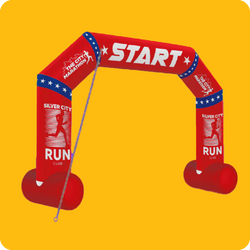How to Take Down a Canopy Tent

How to Take Down a Canopy Tent
Ever find yourself scratching your head, wondering how to take down that canopy tent after a successful event? Whether it's your first time or you've been through a few, taking down a canopy tent can seem daunting. In this guide, we'll walk you through the step-by-step process.
We'll help you ensure that your tent comes down as smoothly as it went up, from the basic fold down to packing it away neatly.
Why It's Important to Take Down a Canopy Tent Correctly
Taking down your canopy tent might seem like the last, simple step of your event, but following the proper steps is crucial. Here's why doing it right matters every time:
To Prevent Damage to the Tent
Your canopy tent is an investment, and you want it to last like any good investment. Incorrect disassembly can lead to torn fabric, bent poles, and broken truss bars. These minor inconveniences can render your tent unusable for future events.
Following step-by-step instructions ensures that every part of your tent maintains its integrity and is ready for the next setup.
To Save Time and Effort
Knowing the right way to take down your best pop-up gazebo or canopy tent saves you time and hassle. Proper disassembly means you can pack your tent away neatly, making it easier to transport and set up next time. Plus, when everything fits back into its carry bag without a struggle, you save yourself a lot of future frustration.
To Maintain the Warranty
Many canopy tents have warranties that require you to follow manufacturer instructions for tent setup and takedown. Ignoring these guidelines can void your warranty, leaving you without support if something goes wrong.
To Avoid Unnecessary Repairs
Tents are designed to withstand the elements but aren't invincible, especially when dismantled incorrectly. Avoiding rough handling and improper folding reduces the risk of causing preventable wear and tear.
This means less time spent on repairs or searching for replacement parts like sidewalls or tent stakes and more time enjoying your canopy's shade and shelter.
To Preserve Resale Value
There may come a time when you decide to upgrade to a larger tent or a heavy-duty pop-up canopy tent better suited for high winds.
When that day comes, you'll find that your careful maintenance and correct disassembly have kept your tent in top condition, preserving its resell value. A well-looked-after tent can be a selling point, ensuring you get a good return on your original purchase.
To Keep the Setup Process Smooth for Next Time
When you take your tent down correctly, you're prepping it for an easy next setup. This includes properly securing Velcro straps, smoothly rolling up the canopy tops, and organizing components like the frame and tent legs. It's a cycle of care taken down with attention, and the next canopy setup will be straightforward and frustration-free.
How To Take Down Your Canopy Tent Safely
Gather your Tools and Help
Before anything else, ensure you have everything you need within reach. This includes your carry bag, tent stakes, and any sandbags or weights you've used. Enlisting a helper or two is also a good idea, especially for larger tents.
Remove Sidewalls and Accessories
If your tent has sidewalls, begin by carefully detaching them. Unhook any Velcro or ties securing the side walls to the tent frame.
Lower the Canopy
Most canopy tents have a mechanism to adjust the height. Lower the tent to its lowest setting to make the canopy more accessible. You'll prevent strain on the tent's frame and fabric during takedown.
Release the Frame
Instant pop-up canopy tents usually have a central mechanism or buttons at the corners that must be pressed to collapse the frame. Press this button simultaneously and gently with a person at each side to start collapsing the tent. Be mindful to do this evenly to avoid bending the frame.
Fold the Canopy Top Simultaneously
Once the frame is collapsed, carefully fold or roll the canopy top. This is where being gentle pays off. You want to avoid creasing or damaging the fabric. Follow any specific folding instructions your tent came with to ensure the fabric remains in good condition.
Pack the Frame
After the canopy is removed, turn your attention to the frame. Collapse it fully according to the manufacturer's instructions. Ensure all the truss bars are folded, and the tent legs are brought together. If your tent came with a bag, now's the time to gently slide the frame inside.
Store Canopy and Accessories
Finally, place the folded canopy, side walls, and other tent accessories into their bags. Keeping everything organized prevents items from getting lost or damaged. If your tent has separate bags for the steel frame and fabric, use them as intended to avoid unnecessary wear.
Review for Damage
Before you call it a day, inspect the tent for any signs of damage. Addressing issues now can save you time and trouble later. Check the fabric for tears, the frame for bends, and the bag for rips.
Extra Tips for Making Your Canopy Tent Last
Keep It Dry
Before packing away the fabric components, like the canopy top and sidewalls, ensure they are completely dry. Storing wet fabric can lead to mildew and mold, weakening the material and creating unpleasant odors. If you must pack the tent away while it's still damp, make it a priority to air it out as soon as possible.
Use Protective Bags
Most canopy tents come with carry bags for the frame and the fabric. Always use these bags for storage. If your tent doesn't come with a bag or it's damaged, consider investing in a high-quality replacement.
Store in a Cool, Dry Place
Find a cool and dry storage spot to prevent damage from humidity or extreme temperatures. Avoid places like damp basements or hot attics. Consistent moderate conditions are best to maintain the integrity of the tent's materials over time.
Avoid Folding the Fabric the Same Way Every Time
When packing away the fabric parts of your tent, try to fold them differently each time. This prevents creases from becoming permanent and weakening the fabric.
Label Everything
Labeling each part and bag can save you a lot of hassle if your tent has many components or if you own multiple tents. Knowing exactly what goes where can make your next setup much faster and smoother.
Shop Canopy Tents that Are Sturdy Enough to Reuse
Now that you've learned how to take down and care for your canopy tent, the next step is to ensure you have a tent that's up to the task.
Do you need a sturdy pop-up canopy tent for outdoor events or trade shows? You may need a water-resistant party tent for a special occasion. Our products meet many needs while promising easy setup and takedown.
With the right care, our custom canopy tents are more than a one-time investment. They're a long-term solution for all your outdoor event needs. So why not reach out to us today?































